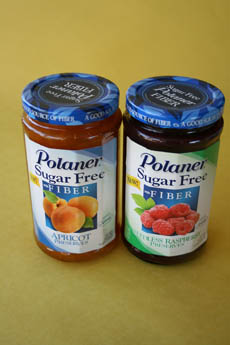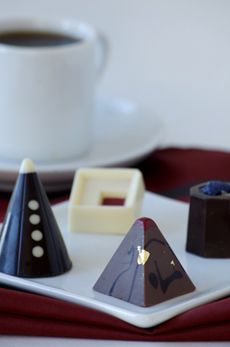
Apricot and Raspberry, two of the six flavors
of Polaner’s Sugar-Free Preserves with Fiber.
Photo by Hannah Kaminsky | THE NIBBLE. |
|
Why add fiber to sugar-free preserves?
According to the American Journal of Clinical Nutrition, most of us don’t get enough fiber in our diet. On average, American women get 12 grams per day; American men get 18.
Experts say we should get from 25 to 40 grams of fiber daily to help support a healthy digestive system, reduce the risk of heart disease and manage our weight (fiber is more filling). That’s why when you have a choice of eating foods with more fiber or less, you’re better off choosing more (most fruits and vegetables are high on the fiber list).
If you’re on a sugar-free or reduced-sugar diet, chances are that you’re already eating lots of good fruits and veggies. But now it’s sweeter to get an extra 3 grams of fiber (about 12% of your daily requirement), with every tablespoon of Polaner Sugar-Free Preserves with Fiber. They’re sweetened with Splenda.
We’ve been enjoying these jams—yes, they’re actually jam, not preserves (more about that in a minute)—since their debut, around the beginning of November 2009 (sorry we’re late in sharing the news). |
| We use the Raspberry and Strawberry to glam up our nonfat plain Greek yogurt (Chobani, FAGE Total and Oikos—we love ‘em all)—to delightful results. Similarly, we use it to top our Breyer’s Extra Creamy No Sugar Added Vanilla Ice Cream.Polaner recommends it on toast and muffins, of course; as an addition to smoothies or cookie dough, or whisked into oil and a bit of vinegar for a marinade.
The line is certified kosher. It’s just 10 calories per tablespoon, and for you carb counters:
– Sugar Free Apricot Preserves with Fiber: 4g carbs – 3g fiber = 1g net carb
– Sugar Free Blackberry with fiber: 5g carbs – 3g fiber = 2g net carbs
– Sugar Free Grape with Fiber: 4g carbs – 3g fiber = 1g net carb
– Sugar Free Orange Marmalade: 5 carbs – 3g fiber = 2g net carbs
– Sugar Free Raspberry with Fiber: 5g carbs – 3g fiber = 2g net carbs
– Sugar Free Strawberry with Fiber: 5g carbs – 3g fiber = 2g net carbs
COUPON: You can get a $1.00 coupon here. If you don’t have the Java aplet for printing coupons, start at the Polaner home page.
- Now about the difference between jam and preserves: Jam can be a purée of fruit or have a soft pulp, but it does not contain chunks of fruit. The two Polaner flavors we had were purées, without chunks of fruit. Preserves differs from jam in that large or whole pieces of fruit are suspended in a syrup base. The texture of preserves is not smooth like jelly or jam.
- See the differences among all the spreads—jelly, curd, marmalade, etc.—in our Jam & Jelly Glossary.
- Find more of our favorite sugar-free foods in our Diet Nibbles Section.
|




